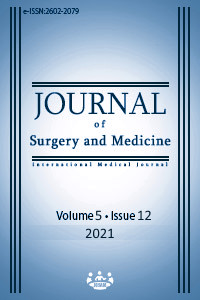A comparison of the harmonic scalpel, coblation, bipolar, and cold knife tonsillectomy methods in adult patients
Keywords:
Harmonic scalpel, Tonsillectomy, Coblation, Cold knife tonsillectomy, Bipolar dissection, Postoperative painAbstract
Background/Aim: Tonsillectomy is one of the widely performed surgical procedures by otolaryngologists. Today, many new surgical instruments are used in tonsil surgery to reduce postoperative morbidity. This study aimed to compare intraoperative blood loss, operating time, postoperative pain, and bleeding between harmonic scalpel tonsillectomy, coblation tonsillectomy, bipolar tonsillectomy, and cold dissection tonsillectomy in adult patients. Methods: This prospective cohort study population comprised 96 adult patients aged 18-60 years (mean age: 34.9 (10.7) years) who were operated on for chronic tonsillitis. The amount of bleeding and the operation time were calculated intraoperatively. Postoperative pain level was evaluated using a Visual Analogue Scale (VAS) at the sixth postoperative hour and on postoperative days 1, 2, 3, and 7. Results: In the harmonic scalpel group, the mean volume of intraoperative bleeding (2.7 (1.5) ml) and the mean operation time (8.8 (3.0) min) were significantly lower compared to the other groups (P<0.001, P<0.001 respectively). Secondary bleeding was detected in 10 patients but there was no significant difference in the post-tonsillectomy bleeding rates between the four groups (P=0.86). Pain scores at the sixth postoperative hour were similar and significantly lower in the harmonic scalpel, coblation, and bipolar groups compared with the cold dissection group (P<0.001). The postoperative pain scores were significantly higher in the harmonic scalpel group compared to the cold dissection group on postoperative days 3 and 7 (P=0.03, P=0.02 respectively). Conclusion: Less bleeding during surgery, shorter operation time, and less pain in the early postoperative period are the advantages of Harmonic scalpel tonsillectomy. Also, it does not increase the rate of secondary bleeding but its benefit for late period pain is lower compared to the cold knife method. The harmonic scalpel is a practical and reliable method in adult tonsil surgery.
Downloads
References
McClelland L, Jones NS. Historical article tonsillectomy: hemorrhaging ideas. J Laryngol Otol. 2005;119(10):753-8.
Dutta NN, Bordoloi BM. Tonsillectomy using harmonic scalpel. Indian J Otolaryngol Head Neck Surg. 2002;54(1):74-6.
Kamal SA, Basu S, Kapoor L, Kulandaivelu G, Talpalikar S, Papasthatis D. Harmonic scalpel tonsillectomy: a prospective study. Eur Arc Otorhinolaryngol. 2006;263(5):449-54.
Timms MS, Temple RH. Coblation tonsillectomy, a double blind randomized controlled study. J Laryngol Otol. 2002;116(6):450-2.
Pang YT, El-Hakim H, Rothera MP. Bipolar diathermy tonsillectomy. Clin Otolaryngol Allied Sci. 1994;19(4):355-7.
Verma R, Verma RR, Verma RR. Tonsillectomy-comparative study of various techniques and changing trend. Indian J Otolaryngol Head Neck Surg. 2017;69(4):549-58.
Sayın I, Cingi C. Recent medical devices for tonsillectomy. Hıppokratia. 2012:16(1):11-6.
Galindo Torres BP, Miguel Garcia FD, Orozco JW. Tonsillectomy in adults: Analysis of indications and complications. Auris Nasus Larynx. 2018;45(3):517-21.
Hoddeson EK, Gourin CG. Adult tonsillectomy: current indications and outcomes. Otolaryngol Head Neck Surg. 2009;140(1):19-22.
Karimi E, Safaee A, Bastaninejad S, Dabiran EM, Salehi FM. A comparison between cold dissection tonsillectomy and harmonic scalpel tonsillectomy. Iran J Otorhinolaryngol. 2017;29(95):313–7.
Akural EI, Koivunen PT, Teppo H, Alahuhta SM, Löppönen HJ. Post-tonsillectomy pain: a prospective, randomized and double blinded study to compare an ultrasonically activated scalpel technique with the blunt dissection technique. Anaesthesia. 2001;56(1):1045-50.
Parsons SP, Cordes SR, Comer B Comparison of posttonsillectomy pain using the ultrasonic scalpel, coblator, and electrocautery. Otolaryngol Head Neck Surg. 2006;134(1):106-13.
Basu S, Sengupta A, Dubey AB, Sengupta A. Harmonic scalpel versus coblation tonsillectomy a comparative study. Indian J Otolaryngol Head Neck Surg. 2019;71(4):498-503.
Arbin L, Enlund M, Knutsson J. Post-tonsillectomy pain after using bipolar diathermy scissors or the harmonic scalpel: a randomised blinded study. Eur Arch Otorhinolaryngol. 2017;274(5):2281-85.
Sheahan P, Miller I, Colreavy M, Sheahan JN, McShane D, Curran A. The ultrasonically activated scalpel versus bipolar diathermy for tonsillectomy: a prospective, randomized trial. Clin Otolaryngol Allied Sci. 2004;29(5):5330-44.
Downloads
- 672 912
Published
Issue
Section
How to Cite
License
Copyright (c) 2021 Buğra Subaşı, Fatih Oğhan, Hamdi Taşlı, Nesibe Esra Karaman, Seçkin Akbal
This work is licensed under a Creative Commons Attribution-NonCommercial-NoDerivatives 4.0 International License.
















